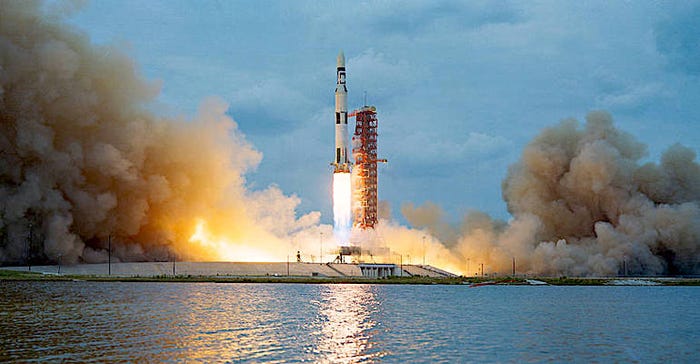Remembering Skylab 50 Years On
Launch damage to NASA’s first space station forced Apollo 13-style engineering improvisation.

NASA launches the Skylab space station atop a Saturn V rocket, April 14, 1973.NASA
Skylab was NASA’s first space station, fashioned out of the upper stage of a Saturn V moon rocket made redundant by the decision to shorten the Apollo moon landing program to just seven landing attempts. Apollo 13 famously did not land on the moon due to the explosion of a Command Module oxygen tank en route to the moon.
One of the surplus Saturn Vs was used to launch Skylab on May 14, 1973, while smaller Saturn 1Bs were used to launch crews to the station. For the first mission, NASA positioned the Saturn V with Skylab on Launch Pad 39A while the Saturn 1B for the crew was on Launch Pad 39B for launch the day after the station. It was the only time NASA ever had two Saturn rockets on the pads at the same time.
Launch
Launch of the first Skylab crew was delayed ten days while NASA engineers scrambled to devise solutions to the damage the station suffered on launch when the meteorite shield/sunshade tore loose and ripped off one of the station’s two solar arrays. Worse yet, cables to the damaged components got wrapped around the remaining solar panel, preventing its deployment.
The station did have another separate array of four solar panels that spread like flower petals from the Apollo Telescope Mount (ATM), which carried a camera for studying the sun. Those panels only powered that device, however. Even those panels had a problem when the power conditioner managing power generated by the ATM’s panels didn’t work properly. However, NASA technicians on the ground remembered having the same problem during ground tests and sent their recommended fix: whack it with a hammer. That repair worked, saving the ATM’s mission.
Troubleshooting
The first crew was also tasked with freeing the remaining solar panel so it could be deployed to run the station on half the expected power. Inside, Skylab was separated into two "floors;" the "upper" floor contained storage lockers and a large empty space for conducting experiments, and two airlocks, one pointed "down" toward the earth and the other "up" toward the sun; the "lower" floor was divided into rooms including a dining room with a table, three bedrooms, a work area, a bathroom, and a shower. The floors consisted of an open gridwork that fit cleats on the bottom of the astronauts' shoes.
Repair work cost a significant portion of the mission’s four-week duration. During the time remaining in orbit, the crew managed to achieve nearly 100 percent of the projected medical research goals for the mission. The crew also managed to accomplish most of the assigned tasks involving the observation of solar activity, eventually taking more than 25,000 pictures of the sun. The first crew never fully caught up, but still managed to complete an estimated 60 percent of the planned earth resources experiments.
Subsequent Missions
The first crew returned to Earth on June 22 and was followed by two subsequent crews, from July-Sept. 1973 and Nov. 1973-Jan. 1974.
Three missions were all that Skylab ever hosted, as NASA planned to boost its orbit periodically with the Space Shuttle. However, that vehicle’s development was repeatedly delayed, and the Space Shuttle Columbia launched for the first time in April 1981, two years after Skylab fell back to Earth.
Click through the photo gallery for a look at some of Skylab’s accomplishments.
About the Author(s)
You May Also Like





